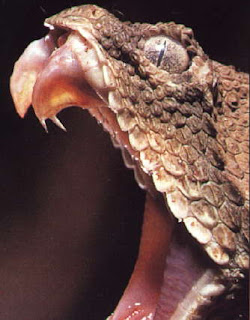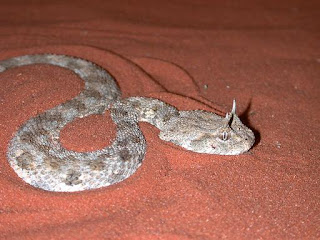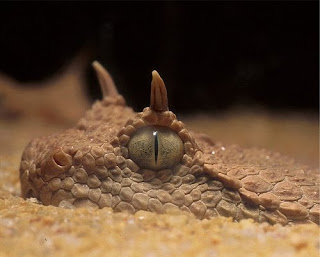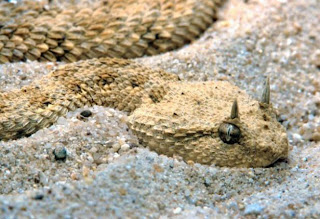 The Desert Horned Viper with its Anvil Shaped Head, Satanic Horns and Cat Like Eyes
The Desert Horned Viper with its Anvil Shaped Head, Satanic Horns and Cat Like Eyes The Desert Horned Viper with its Anvil Shaped Head, Satanic Horns and Cat Like Eyes
The Desert Horned Viper with its Anvil Shaped Head, Satanic Horns and Cat Like Eyes The Desert Horned Viper with its Anvil Shaped Head, Satanic Horns and Cat Like Eyes
The Desert Horned Viper with its Anvil Shaped Head, Satanic Horns and Cat Like EyesSize and shape: Usually just under two feet long, strong and cylindrically depressed body, narrow neck, abdomen thick, tapering tail.
Head: Broad, flat and round-snouted, with the center-toothed (or keeled) scales; forward-set eyes big enough with a vertical pupil (like the people of southwestern rattlesnakes); special supraorbital horns (which are not always present in all populations or even individuals); hinged hollow fangs that snap into position when the snake opens its mouth to bite.
Color and pattern: yellow, brown, reddish-gray in color, often matching the color of the soil surface; darker and more or less rectangular patch along the back.
Head: Broad, flat and round-snouted, with the center-toothed (or keeled) scales; forward-set eyes big enough with a vertical pupil (like the people of southwestern rattlesnakes); special supraorbital horns (which are not always present in all populations or even individuals); hinged hollow fangs that snap into position when the snake opens its mouth to bite.
Color and pattern: yellow, brown, reddish-gray in color, often matching the color of the soil surface; darker and more or less rectangular patch along the back.
